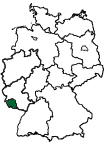-
Early Industrialization, Migrant
Workers and Changing Territories
Aside from the city-states of Hamburg,
Bremen and Berlin, Saarland is Germany's smallest state. Saarland, takes
its name from the River Saar, which separates this state from neighboring
France and Luxembourg. Saarland has always been at the crossroads of European
history. The national status of the state has changed no less than eight
times within the past 200 years. Some early medieval territories,
such as the Duchies of Palatinate-Zweibrücken and Lorraine, the Electorate
of Trier and the Earldom of Nassau Saarbrücken are still represented
in its coat of arms. Following the French Revolution, local rulers were
expelled and the area was annexed by France. After the Congress of Vienna,
Saarland came under Prussian and Bavarian rule. The Grand Duchy of Oldenburg
also held a small land-claim in Saarland. Only after the turbulent 19th
and 20th century struggles between France and the German Empire had subsided,
did Saarland finally become part of the newly formed German Republic in
January of 1957. The French Franc was, however, still an accepted
currency in Saarland as late as 1959.
The ongoing changes in its territorial status
make it quite complicated for researchers to keep track of the documentation
of emigrants from this region. As a basic rule, most of the Saarland emigrants
left the country as subjects of the Kingdom of Prussia or Bavaria.
Regardless of any historic specifications, the area is prominently referred
to as part of the Palatinate, i.e. in the case of the Dukedom of Zweibrücken.
The French Royal Deux Ponts regiment that fought in the American Revolution
on American side was recruited from this Duchy. Saarland and Palatinate
soldiers, furthermore, were influential in the capitulation of British
forces at Yorktown.
The history and culture of Saarland have always
been influenced by its coal mines and its iron and steel industries. Early
industrialization, from the 1840's onwards, attracted many poor farmers
from surrounding areas. Many of these people would be considered today
as migrant workers. Some of them had to walk up to 15 miles from their
hometowns to the industrial sites where they were employed. They soon became
known as "Hartfüßler" or literally, those with hardened feet.
Seasonal migration happened to be a part of their daily lives, before many
of them made their final decision to go to America. Between 1840 and 1850,
7,500 emigrants left the rural areas around Merzig, St. Wendel and Saarlouis.

Research and Travel offers:
Guided tours in Germany
Research services for your roots in Germany
|

Soldier of the Royal Deux Ponts Regiment
|





